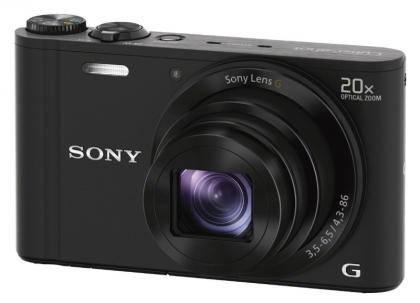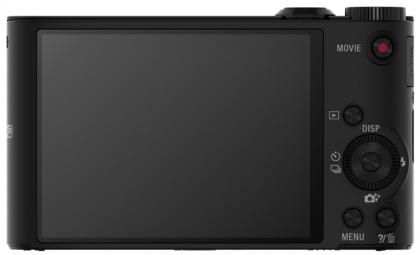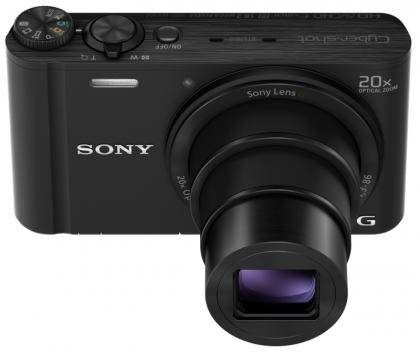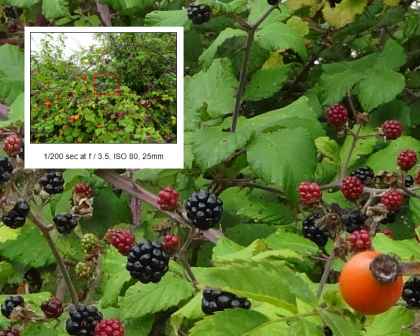We've become used to having 20x zooms in pocket-sized cameras, but the Sony WX300 sets a new standard for miniaturisation. At just 26mm thick and 165g, it slips easily into jeans pockets. There's no skimping on the features, though, with a 3in LCD screen, mode dial, rear wheel and integrated Wi-Fi. The battery isn't particularly big but it gives 500 shots from a single charge – almost double the average for pocket ultra-zoom cameras.

We appreciate the light, slim design but we'd have preferred for the camera to be a little wider. The buttons to the right of the screen are tiny and there's not a huge amount of unadorned space to hold onto. Something to grip onto on the front would have been welcome, too.

Otherwise, this is a rewarding camera to use. It's quick to focus, and can rattle off a photo every 0.8 seconds. Continuous shooting is at 6.6fps for 10 frames, and there's an eight second wait while it's saving them before it's ready to go again. In most shooting modes, there's quick access to brightness, colour (for warmer or cooler tones), vividness and creative effects. These functions are likely to mean more to casual users than traditional controls such as exposure compensation and white balance. Those are available too in Program mode for those who want them. We doubt that many people will begrudge the lack of manual exposure controls, but the inability to move the autofocus point might be more frustrating.

The Wi-Fi implementation is friendlier than most. The second function in the camera's menu is labelled Ctrl with Smartphone. The accompanying iOS or Android apps are straightforward, with the ability to capture photos, videos and zoom in and out and control the flash and self-timer. This simplicity means a smart, uncluttered interface, with a preview that fills the smartphone's screen in portrait orientation. 1.5-megapixel copies of photos are transferred within a couple of seconds of capture, with options to forward them directly to another app. However, it's not possible to jump directly to browsing the camera's card contents. To do this, we had to terminate the connection, put the camera into playback mode and then select a Send to Smartphone option from the menu. Browsing and copying was fast, though, with a choice of resolutions and support for MPEG-4 (but not AVCHD) video files.
VIDEO AND IMAGE QUALITY
Video quality was good rather than excellent. Colours looked a little flat, and low-light clips were quite scruffy. We're not too keen on the interlaced format that the camera records by default, although it's possible to avoid this by switching from AVCHD to MPEG-4 capture. This limits recording to 1,440x1,080 rather than the usual 1,920x1,080 pixels per frame (with clips stretched to widescreen shape on playback) but it didn't damage picture quality too much.
Image quality was generally OK but neither the sensor nor the lens stood up to scrutiny – or to comparisons with rival cameras. Focus in wide-angle shots was sharp in the centre of frames but deteriorated towards the edges. As we zoomed in, it got worse in the centre too. At a 300mm (equivalent) focal length, it was trailing in last place for focus compared to other pocket ultra-zoom cameras. It stayed in last place at the full 500mm zoom extension, too.

Details in this wide-angle shot look good enough to eat
Focus in wide-angle shots is much better in the centre than it is towards the edges
Focus is a little soft in this medium-telephoto shot, giving a slight haze to details
Things are looking decidedly syrupy at the full zoom extension at ISO 250
Noise reduction is already working hard at ISO 400
Meanwhile, the 18-megapixel sensor struggled with noise when scenes demanded fast ISO speeds. At ISO 400 and above, subtler details were replaced by smudgy noise reduction, and ISO 1600 shots looked decidedly scruffy. Shooting shady subjects at the full zoom extension produced a double whammy of soft focus and heavy noise reduction, resulting in nondescript smears of colour. We got some great results from the 18-megapixel sensor in the Sony WX200 a few months ago, but this doesn't appear to be the same sensor – noise levels were significantly higher.
It's a shame, because the WX300 has a lot going for it. We could have overlooked a few quibbles regarding image quality, but these problems were visible even at modest viewing sizes. For us, that knocks it out of the running and the Canon PowerShot SX280 HS is the better buy.
|
Basic Specifications |
|
Rating |
*** |
|
CCD effective megapixels |
18.0 megapixels |
|
CCD size |
1/2.3in |
|
Viewfinder |
none |
|
Viewfinder magnification, coverage |
N/A |
|
LCD screen size |
3.0in |
|
LCD screen resolution |
460,800 pixels |
|
Articulated screen |
No |
|
Live view |
Yes |
|
Optical zoom |
20.0x |
|
Zoom 35mm equivalent |
25-500mm |
|
Image stabilisation |
optical, lens based |
|
Maximum image resolution |
4,896x3,672 |
|
File formats |
JPEG; AVCHD, MP4 (AVC) |
|
Physical |
|
Memory slot |
SDXC, Memory Stick Pro HG Duo |
|
Mermory supplied |
50MB internal |
|
Battery type |
Li-ion |
|
Battery Life (tested) |
500 shots |
|
Connectivity |
USB, micro HDMI, Wi-Fi |
|
Body material |
aluminium and plastic |
|
Lens mount |
N/A |
|
Focal length multiplier |
N/A |
|
Kit lens model name |
N/A |
|
Accessories |
USB cable |
|
Weight |
165g |
|
Size |
57x96x26mm |
|
Buying Information |
|
Warranty |
one year RTB |
|
Price |
£200 |
|
Supplier |
http://www.currys.co.uk |
|
Details |
www.sony.co.uk |
|
Camera Controls |
|
Exposure modes |
auto |
|
Shutter speed |
auto |
|
Aperture range |
f/3.5 (wide), f/6.5 (tele) |
|
ISO range (at full resolution) |
80 to 3200 |
|
Exposure compensation |
+/-2 EV |
|
White balance |
auto, 7 presets, manual |
|
Additional image controls |
none |
|
Manual focus |
No |
|
Closest macro focus |
5cm |
|
Auto-focus modes |
multi, centre, spot, face detect |
|
Metering modes |
multi, centre-weighted, centre, face detect |
|
Flash |
auto, forced, suppressed, slow synchro, red-eye reduction |
|
Drive modes |
single, continuous, self-timer, panorama, HDR, 3D |
Basic Specifications
Physical
Buying Information
Camera Controls